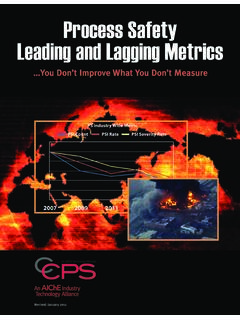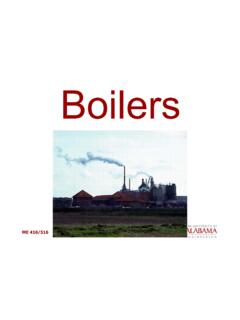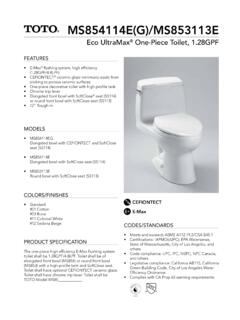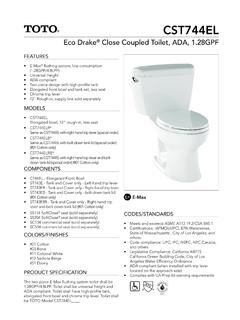Transcription of Introduction to Fluidization - AIChE
1 CEP November 2014 21 Back to BasicsFluidized-bed processes have operated commercially since the 1920s, beginning with the advent of the Winkler coal gasifier in Germany. Fluidized catalytic cracking units (FCCUs) for the production of high-octane gasoline and fluidized-bed reactors for making phthalic anhydride debuted in the 1940s. Today, about three-quarters of all polyolefins are made by a fluidized-bed process. The development of a specialized zeolite catalyst for cracking heavy oil into various fractions enabled the com-mercialization of the FCC circulating fluidized bed. In this process, oil is injected into a riser, and the feedstock and catalyst flow upward. As the oil is cracked, a layer of coke (a high-molecular-weight carbonaceous material) builds up on the catalyst, deactivating the catalyst in a matter of seconds.
2 The coke is removed and the catalyst reactivated in a fluidized-bed regenerator. Fluidized beds typically are more complex to design, build, and operate than other types of reactors, such as packed-bed and stirred-tank reactors. Scaleup of fluidized beds can be difficult (1). Fluidized beds are prone to erosion and particle attrition caused by the moving particles. Solids losses can result in significant operating costs, especially when the solid particles are an expensive catalyst. Bubbles also need to be managed, as large bubbles can travel faster than smaller bubbles in a fluidized bed, which reduces the mass transfer between phases. Despite these challenges, fluidized beds offer three distinct advantages over other process technologies: superior heat transfer, the ability to easily move solids like a fluid, and the ability to process materials with a wide particle size distribution.
3 The heat-transfer rate in a fluidized bed can be five to ten times greater than that in a packed-bed reactor. Moving particles, especially small particles, can transport heat much more efficiently than gas alone. Even for the most extreme exothermic reactions, a fluidized bed can maintain an iso-thermal profile within a few degrees. The acrylonitrile process, for example, capitalizes on this benefit. The reaction of propylene with ammonia and oxygen has an exothermic heat of reaction on the order of 515 kJ/mol and the product is prone to thermal degradation. Yet, acrylonitrile can be made in a fluidized bed with less than 5 C of variability in the reactor temperature. Another benefit of fluidized beds is the ability to move solids in a fluid-like fashion.
4 Catalyst can be added or removed from the reactor without requiring a shutdown. Furthermore, in many cases, the entire inventory of catalyst can be removed and replaced in less than a day whereas it would take many days or weeks to uniformly fill a packed-bed reactor with fresh catalyst. In addition, reactors can be coupled such that the catalyst can be cycled and regenerated; the FCC circulating fluidized-bed reactor is based on this advantage. Thus, the benefits of using fluidized-bed technology can easily outweigh the disadvantages, especially for processes requiring catalyst circulation or superior heat transfer or both. Reaping these benefits, however, requires a good understanding of Fluidization . Fluidization theory Particles become fluidized when an upward-flowing gas imposes a high enough drag force to overcome the down-ward force of gravity.
5 The drag force is the frictional force imposed by the gas on the particle; the particle imposes an Fluidized beds offer excellent heat transfer, and have the unique ability to move a wide range of solid particles in a fluid-like fashion. This article explains the basics of Fluidization theory and outlines how to design a typical fluidized CoccoS. B. Reddy KarriTed KnowltonParticulate Solid Research, Inc. (PSRI) Introduction to FluidizationCopyright 2014 American Institute of Chemical Engineers ( AIChE )22 November 2014 CEPBack to Basicsequal and opposite drag force on the gas. Thus, as a particle becomes more fluidized, it affects the local gas velocity around it due to these drag forces. This effect is minimal for spherical particles, but the influence of the drag force is more significant for irregularly shaped particles.
6 Figure 1 shows the increase in pressure drop with increasing superficial gas velocity through a bed of par-ticles that is initially packed. As the superficial gas veloc-ity increases, the pressure drop across the bed increases in accordance with the Ergun equation (2). When the gas veloc-ity is high enough that the drag force on the particles equals the weight of the particles ( , m g), the bed becomes flu-idized. This point is commonly referred to as the minimum Fluidization velocity, umf. Higher gas velocities do not create higher pressure drop, because at this point the pressure drop is due solely to the weight of the suspended bed. Thus, the inventory of any fluidized bed can be determined by measur-ing the pressure drop across the bed and calculating the bed height (3): where Pbed is the pressure drop across the bed, Hbed is the height of the bed when fluidized, g is the acceleration due to gravity, gc is the force-weight conversion factor, p is the particle density, is the bed voidage ( , gas volume frac-tion), g is the gas density, and bulk is the bulk density.
7 The gas density is minimal compared to the bulk density and can be disregarded in Eq. 1. The minimum Fluidization velocity, umf, can be estimated for spherical particles by first calculating the Archimedes number, Ar: where dp is the Sauter mean particle size and is the fluid viscosity. The Wen and Yu equation (4) is a second-order polynomial with respect to the particle Reynolds number calculated at the minimum Fluidization velocity, Rep,mf: After calculating the Archimedes number, the Reynolds number can be determined using the quadratic equation or an equation solver. Finally, the minimum Fluidization velocity, umf, can be determined after solving for Rep,mf: Other minimum Fluidization correlations exist, but Eq. 3, based on the work of Wen and Yu (4), is the most popular.
8 When the gas velocities increase beyond the minimum Fluidization velocity, bubbles can form. The point at which this occurs depends on the particle size and density. Smaller or lighter particles tend to experience smooth Fluidization before bubbles appear. Larger or denser particles tend to start bubbling at the point of minimum Fluidization . The movement of a gas through a fluidized bed can best be described using the two-phase theory (5). According to this theory, gas moves through the bed in two ways as bubbles, and as part of an emulsion (or dense) phase as illustrated in Figure 2. The two-phase theory is represented by the equation: where Qbed is the total gas volumetric flowrate through the bed, Qemulsion is the gas volumetric flowrate through the dense phase, Qbubbles is the gas volumetric flowrate through the bubbles, Abed is the cross-sectional area of the bed, and uo is the superficial gas velocity.
9 Up to the minimum Fluidization point, all the gas moves through the bed via the emulsion phase. Beyond the minimum Fluidization point, any additional gas introduced should travel through the bed as bubbles. Thus, bubbles can be considered as the gas bypassing the process, which is det-rimental for mass-transfer-limited processes, such as some heterogeneous reactions. Larger bubbles travel faster than smaller bubbles, so managing bubble size is an important design criterion. In reality, Eq. 5 is not completely correct. First, small p Figure 1. This typical minimum Fluidization curve shows that the pressure drop (red line) increases with superficial gas velocity until the point at which the gas velocity is high enough that the drag force is equal to the weight of the particle.
10 At this point, the minimum Fluidization velocity, the bed becomes fluidized, and the bed height (blue line) Gas Velocity (uo) pressure Drop ( P/L)Bed Height (Hbed)umfQemulsionQbubblest Figure 2. According to the theory of two-phase Fluidization , gas moves through the particle bed as bubbles and as an emulsion (or dense phase).Copyright 2014 American Institute of Chemical Engineers ( AIChE )CEP November 2014 23particles can experience smooth Fluidization before bubbles form ( , the region between the minimum Fluidization and minimum bubbling velocities). Second, a small amount of gas leaks into and out of the bubbles. Thus, a more accurate version of Eq. 5 is:where umb is the minimum bubbling velocity for the onset of bubbles in the bed and Y is the fraction of the gas in the bubbles (which ranges from 0 to 1).
















